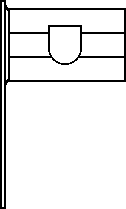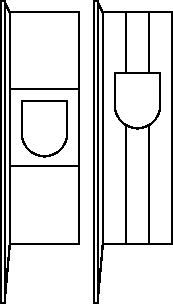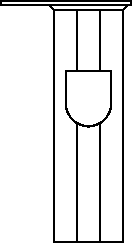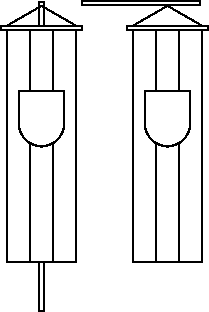 ratio variable, commonly around
3:10~, by Zeljko Heimer
ratio variable, commonly around
3:10~, by Zeljko Heimer[Click for larger view.]

Last modified: 2004-01-29 by marcus schmöger
Keywords: hanging flag | vertical | flapping flag | haengeflagge | banner | knatterflagge | hissflagge |
triangelfahne | haengefahne | knatterfahne |
Links: FOTW homepage |
search |
disclaimer and copyright |
write us |
mirrors
See also:
 ratio variable, commonly around
3:10~, by Zeljko Heimer
ratio variable, commonly around
3:10~, by Zeljko Heimer
[Click for larger view.]
The ratio of the vertical flag is not prescribed (but shown in an accompanying drawing
in Album des Pavillons 2000 as close to 3:10~). It is prescribed always
to be hoisted from a crossbar, and it is forbidden for the vertical flag to include the coat of arms (though, I could
swear I have seen them in use).
Zeljko Heimer, 20 February 2001
One of the biggest problems for vexillologists in Austria is the widespread use of the so-called "Hausfahnen" or "Hängefahnen". Their ratio not being prescribed, they come in all lengths - up to 20 meters suspended from rooftops. This tradition goes back centuries, the advantage being of course that in land-locked, no-navy Austria there are times without wind in which vertical flags "do show" while horizontal flags do not unfurl.
Since the state flag was regulated in 1984, the
vertical flag with an eagle is slowly going out of use, being discouraged by
flagmakers.
Peter Diem, 16 August 2002
Note that vertically hanging flags are part of
the Central European tradition, of which Austria is the core, and it would be
all but logical that these flags would be then used everywhere else around but
in Austria. Vertical flags are in frequent use in Bavaria,
Slovenia, Hungary,
Slovakia etc. As Dr. Diem says, the tradition goes back centuries, and should
not be shunned. And, it should not be a problem for vexillologists. They should
(as we should on FOTW) note the usage and practice, compare it with legislation
etc. Slovenian local flags deal with this problem properly, providing
legislative basis for this custom that is certainly backed with the weather
conditions and wish for the best, most useful and most decorative flag display.
Zeljko Heimer, 20 August 2002
Hißflagge (a.k.a. Flagge, Hißfahne, Querflagge, Querfahne, horizontale Hißflagge, horizontale Hißfahne) |
|
 |
The Hißflagge (often simply called "Flagge") is the "normal" form known
from most countries. It is a flag hoisted on a vertical flagpole. The
Hißflagge is wider than high (in Germany and Austria usually 2:3 or 3:5). Stripes of
German flags are usually arranged from top to bottom (e.g. black-red-gold). A coat-of-arms is usually displayed in the centre
(often slightly shifted to the hoist). In many parts of Germany (especially in the inland states) and in Austria this type of flag would not be considered as the "normal" or "default" type of a flag by most of the people. In Bavaria, for instance, most of the municipal flags are used as a Banner or Hängeflagge or Knatterflagge. Also the federal flag or the Bavarian flag are more frequently used in a vertical format, even by the Bavarian ministries. |
Knatterflagge (a.k.a. Knatterfahne, Hißflagge im Hochformat, Hißfahne im
|
|
 |
The Knatterflagge (more frequently called "Knatterfahne") is a flag that is hoisted on a flagpole like a "normal" flag. However, it is higher than wide (usually around 3:1). On Knatterflaggen the stripes that are arranged from top to bottom in a Hißflagge, are either arranged from top to bottom as well, or from hoist to fly. There seems to be no standardized way to rearrange a Hißflagge into a Knatterflagge, as pointed out in [teo96] and also observed by me on several occasions. |
Auslegerflagge (a.k.a. Auslegerfahne, Galgenflagge, Galgenfahne, Hochformatflagge mit Ausleger, Hochformatfahne mit Ausleger) |
|
 |
This is a variant of the Knatterflagge; it is not only hoisted on the flagpole, but the top of the flag is also fixed to an outrigger, to show the flag fully displayed all the time. This variant is rarely used for official flags, but quite frequently for decorative and commercial flags. |
Hängeflagge (a.k.a. Hängefahne, Hausfahne, Schrägfahne) |
|
 |
The Hängeflagge is directly hoisted from a horizontal flagpole (usually
on a building). The Hängeflagge is higher than wide (from, let's say 3:2
up to 6:1 or even more). Stripes, that are arranged from top to bottom
in a Hißflagge are arranged from left to right in a Hängeflagge. A
coat-of-arms is displayed in upright form, usually in the center or
shifted to the top. A variant is the "Schrägfahne" hoisted from an oblique pole (usually on a building), but hanging down like the Hängeflagge. The terms "Hängefahne" or "Hängeflagge" are frequently mixed up with the term "Banner". |
Banner (a.k.a. Bannerfahne, Triangelfahne) |
|
 |
The Banner is basically a variant of the Hängeflagge. The Banner is
first fixed to a crossbar; then this crossbar is hoisted on a normal
vertical or horizontal flagpole. The Banner is higher than wide (usually
about 5:2 up to 4:1). Stripes, that are arranged from top to bottom in a
Hißflagge are arranged from left to right in a Banner. A coat-of-arms is
displayed in upright form, usually in the center or shifted to the top. The terms "Hängefahne" or "Hängeflagge" are frequently mixed up with the term "Banner". |
Sources:
[heh90] [teo96]
[die95]
Websites of flagmakers and flagsellers with information on the different
forms:
http://www.bofa.de/arten.html
http://www.flaggen.de/Pages/sond_anf.htm
http://www.fahnen-koessinger.de
http://www.fahnen-gruber.de
http://www.fahnen-fuchs.de
http://www.fahnenfabrik.at/11.htm
http://www.fahnen-gaertner.com/produkte.html
http://www.montfortfahnen.at/Produkte/Fahnen/fahnen.html
Marcus Schmöger, 26 October 2001 (with some additions 19 August 2003)